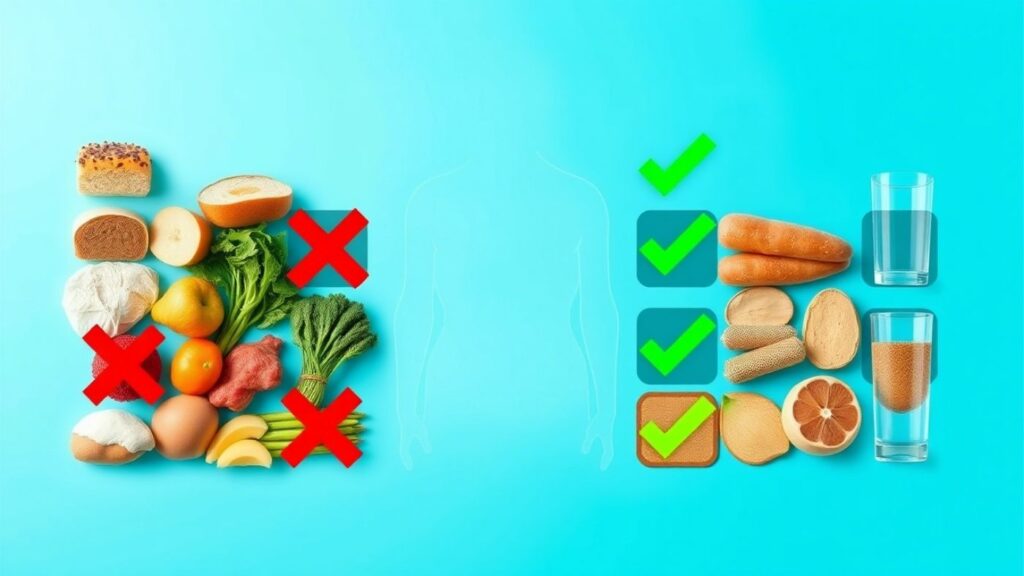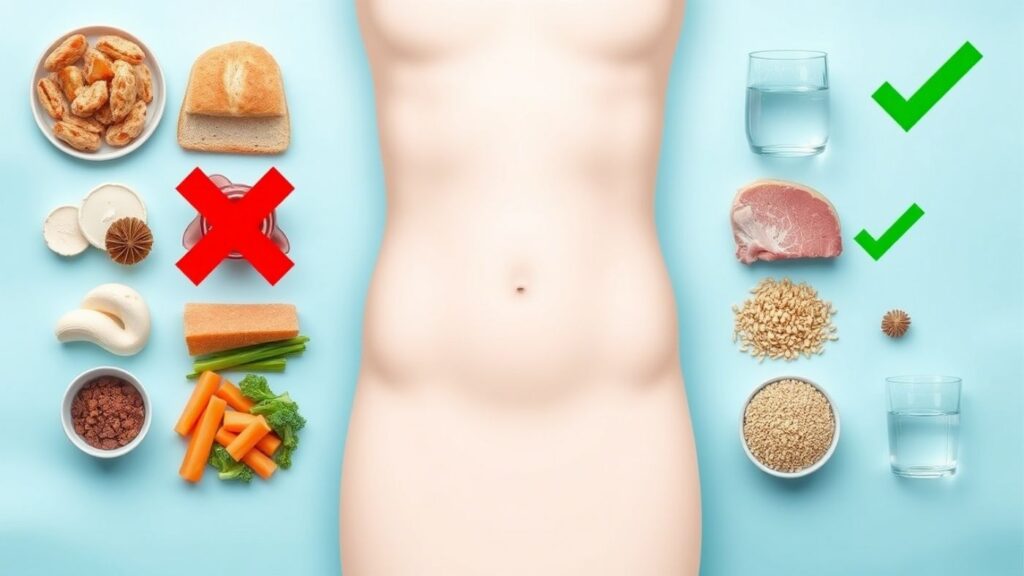Struggling with stubborn belly fat? Your diet choices might be working against you. Learn which foods are sabotaging your weight loss journey and what to eat instead.
Table of Contents
Introduction to What Foods to Avoid When Trying to Lose Belly Fat?
Belly fat isn’t just a cosmetic concern—it’s a health risk that’s been linked to serious conditions like heart disease, type 2 diabetes, and metabolic syndrome. While spot reduction isn’t possible, strategic dietary changes can significantly impact your body’s fat-storing tendencies, particularly around the midsection.
Many people exercise religiously but still struggle with that persistent pouch because they’re unknowingly consuming foods that promote abdominal fat storage. Understanding which foods contribute to belly fat is the first crucial step toward achieving a leaner midsection and improving your overall health.
In this comprehensive guide, we’ll explore the specific foods that may be hindering your efforts to lose belly fat, explain the science behind their effects, and offer healthier alternatives to support your weight loss goals.

Sugar-Laden Foods: The Primary Culprit
When discussing what foods to avoid when trying to lose belly fat, refined sugars top the list. Research published in the Journal of Clinical Investigation has consistently shown that excessive sugar consumption leads to increased fat accumulation, particularly in the abdominal area.
Why Sugar Causes Belly Fat
Sugar triggers several processes that contribute to belly fat:
- It causes spikes in insulin levels, promoting fat storage
- Excess sugar gets converted to fat in the liver through a process called de novo lipogenesis
- It activates reward pathways in the brain, encouraging overconsumption
- Creates a cycle of blood sugar crashes that lead to hunger and more eating
Common Sources of Hidden Sugars
Many foods contain surprising amounts of added sugars:
- Flavored yogurts (can contain up to 30g of sugar per serving)
- Breakfast cereals (even those marketed as “healthy”)
- Condiments like ketchup, BBQ sauce, and salad dressings
- Fruit juices and smoothies from commercial establishments
- Protein and energy bars
- Pasta sauces and other prepared foods
Healthier alternatives: Opt for plain Greek yogurt with fresh berries, homemade dressings with olive oil and vinegar, whole fruits instead of juices, and checking labels for hidden sugars.
Refined Carbohydrates: The Stealth Fat-Promoters
White flour products and other refined carbohydrates act similarly to sugar in the body. These high-glycemic foods quickly convert to glucose in the bloodstream, triggering insulin responses that promote fat storage.
Common Refined Carbohydrates to Avoid
- White bread, rolls, and wraps
- Traditional pasta made from refined wheat
- White rice
- Crackers and chips
- Baked goods like cookies, cakes, and pastries
- Instant oatmeal (the highly processed varieties)
Research from the American Journal of Clinical Nutrition found that people who consumed higher amounts of refined grains had more visceral fat (the dangerous fat surrounding organs) than those who consumed more whole grains.
Healthier alternatives: Choose whole grain bread and pasta, brown or wild rice, quinoa, steel-cut oats, and starchy vegetables like sweet potatoes as your carbohydrate sources.
Trans Fats and Unhealthy Oils: The Double Trouble
Trans fats are perhaps the most harmful dietary fat for your waistline and overall health. These artificial fats have been strongly linked to increased abdominal fat and inflammation.
Sources of Trans Fats and Unhealthy Oils
- Packaged baked goods containing “partially hydrogenated oils”
- Margarine (especially stick varieties)
- Fried foods from restaurants and fast-food chains
- Frozen pizza and microwaveable meals
- Non-dairy coffee creamers
- Cooking oils high in omega-6 fatty acids when consumed in excess (like soybean, corn, and sunflower oils)
A study published in the journal Obesity found that monkeys fed a diet high in trans fats gained significant abdominal fat compared to those fed a diet rich in monounsaturated fats, despite consuming the same number of calories.
Healthier alternatives: Use olive oil, avocado oil, or coconut oil for cooking. Choose foods with natural fats like avocados, nuts, and fatty fish. Check ingredient lists and avoid anything containing partially hydrogenated oils.
Alcohol: The Liquid Belly Fat Promoter
That evening glass (or two) of wine might be sabotaging your weight loss efforts. Alcohol affects your midsection in multiple ways:
- It’s calorie-dense (7 calories per gram) with little nutritional value
- It’s prioritized for metabolism, putting fat burning on hold
- It reduces inhibitions, leading to poor food choices
- It interferes with quality sleep, which affects hunger hormones
- Beer specifically contains phytoestrogens that can promote belly fat in men
Studies indicate that heavy drinking is associated with increased waist circumference, with beer being particularly problematic for creating the infamous “beer belly.”
Healthier alternatives: If you choose to drink, limit consumption to occasional moderate amounts. Opt for red wine (which contains resveratrol) over beer or sugary cocktails, and always alternate with water.
Processed Meats: The Hidden Inflammation Triggers
Processed meats like bacon, sausage, hot dogs, and deli meats are problematic for several reasons:
- They’re high in saturated fats
- They contain sodium nitrates that can cause inflammation
- They’re often high in sodium, which can lead to water retention
- Many contain added sugars and unhealthy preservatives
A study published in the American Journal of Clinical Nutrition found a direct association between processed meat consumption and increased abdominal fat and inflammation markers.
Healthier alternatives: Choose lean protein sources like chicken breast, turkey, fish, eggs, legumes, and occasionally grass-fed beef or pork tenderloin.

Artificial Sweeteners: Not As Helpful As You Think
Many people switch to artificially sweetened foods and drinks to reduce calories, but research suggests these substitutes may actually promote belly fat:
- They can disrupt the gut microbiome, which plays a role in weight regulation
- They may increase cravings for sweet foods by overstimulating taste receptors
- Some studies show they can paradoxically increase insulin resistance
A study published in the journal PLOS ONE found that people who regularly consumed artificially sweetened beverages had a higher risk of weight gain and larger waist circumferences than non-consumers.
Healthier alternatives: Gradually reduce your preference for sweetness by cutting back on all sweeteners. Try flavoring drinks with cucumber, berries, mint, or a splash of fruit juice instead.
What to Eat Instead: Belly Fat-Fighting Foods
While focusing on what to avoid is important, knowing what to include in your diet is equally valuable:
| Food Category | Examples | Benefits for Belly Fat Reduction |
|---|---|---|
| Lean Proteins | Chicken breast, fish, eggs, legumes | Promotes satiety, supports metabolism, maintains muscle mass |
| Healthy Fats | Avocados, olive oil, nuts, seeds | Reduces inflammation, supports hormone production, provides sustained energy |
| Fiber-Rich Foods | Vegetables, fruits, legumes, whole grains | Slows digestion, improves gut health, controls blood sugar |
| Probiotic Foods | Yogurt, kefir, sauerkraut, kimchi | Supports gut microbiome health, may reduce inflammation |
| Anti-inflammatory Foods | Berries, fatty fish, turmeric, green tea | Reduces system-wide inflammation that contributes to fat storage |
Creating a Sustainable Plan for Success
According to the Mayo Clinic, eliminating belly fat requires a comprehensive approach:
- 80/20 principle: Focus on nutritious whole foods 80% of the time, allowing flexibility for occasional treats
- Portion awareness: Even healthy foods can contribute to weight gain when portions are excessive
- Regular physical activity: Combine cardio with resistance training for optimal results
- Stress management: Chronic stress increases cortisol, which promotes abdominal fat storage
- Quality sleep: Aim for 7-9 hours of restful sleep to support hormonal balance
Conclusion
Understanding what foods to avoid when trying to lose belly fat is a crucial component of any effective weight loss strategy. By eliminating or reducing sugar-laden foods, refined carbohydrates, trans fats, alcohol, processed meats, and artificial sweeteners, you create the dietary foundation necessary for reducing stubborn abdominal fat.
Remember that belly fat loss is a gradual process that requires consistency rather than extreme measures. Combined with regular physical activity, stress management, and adequate sleep, these dietary changes can lead to significant improvements in both your waistline and overall health.
Make changes gradually, focus on whole foods, and be patient with your body as it adapts to your healthier lifestyle choices. The most successful approach is one you can maintain long-term.
Frequently Asked Questions
Can I target belly fat specifically through my diet?
Harvard Health Publishing explains that while you can’t spot-reduce fat from specific areas through diet alone, certain dietary patterns do help reduce visceral fat (the dangerous fat around organs) more effectively. Focusing on an anti-inflammatory diet low in added sugars and refined carbs tends to impact abdominal fat preferentially.
While you can’t spot-reduce fat from specific areas through diet alone, certain dietary patterns do help reduce visceral fat (the dangerous fat around organs) more effectively. Focusing on an anti-inflammatory diet low in added sugars and refined carbs tends to impact abdominal fat preferentially.
How quickly will I see results after eliminating these foods?
Most people begin to notice changes within 2-4 weeks of consistent dietary improvements, though individual results vary based on starting point, genetics, and other lifestyle factors. Remember that sustainable weight loss occurs at a rate of 1-2 pounds per week.
Are cheat meals allowed when trying to lose belly fat?
Occasional planned indulgences can be part of a sustainable approach. However, be mindful that some people find “cheat meals” trigger cravings and make it harder to stay consistent. If you include treats, do so mindfully and return to your healthy eating pattern for the next meal.
Is intermittent fasting effective for losing belly fat?
According to research published in the Journal of Translational Medicine, intermittent fasting protocols may help reduce belly fat by improving insulin sensitivity and reducing inflammation. However, the most important factor remains your overall calorie balance and food quality, regardless of eating window timing.